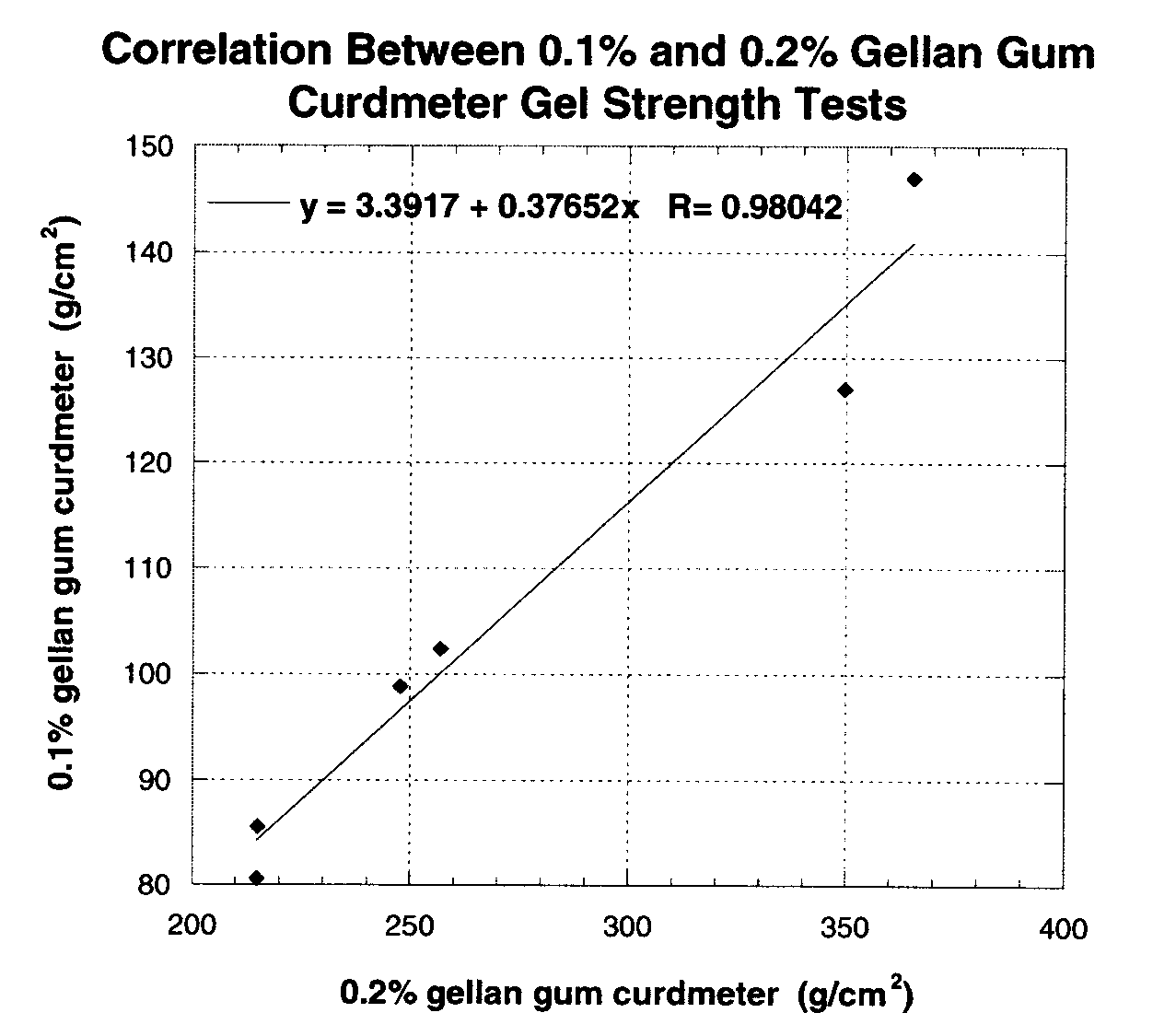High Performance Gellan Gums and Methods for Production Thereof
a gellan gum and high-performance technology, applied in the field of high-performance gellan gums, can solve the problems of reducing the molecular weight of gums produced by native organisms, firm and brittle gels formed,
- Summary
- Abstract
- Description
- Claims
- Application Information
AI Technical Summary
Problems solved by technology
Method used
Image
Examples
example 1
Enzymatic Clarification, Product Recovery, and 0.1% Curdmeter Gel Strength Analysis
[0049]4500 L of fermentor broth from the fermentation (Batch No. GB05662) of a PHB-deficient strain of S. elodea was heated to a temperature of 50° C. and mixed with mechanical agitation. With continued mixing, 200 ppm of sodium sulfite, 100 ppm Lysozyme, and 250 ppm disodium EDTA were added to the fermentor. The reagents were continuously mixed for two hours while the fermentor temperature was controlled to maintain the elevated temperature. Next, 250 ppm of sodium dodecyl sulfate was added to the fermentor broth and agitated for one hour. Afterward, 1000 ppm of protease enzyme was added to the fermentation broth and mixed with the fermentation broth for 3 hours. Potassium hydroxide was added to the broth to achieve a pH of 11.34 in order to deacylate the polysaccharide.
[0050]The broth was recovered by heating to 100° C., adjusting the pH down to 5.59 with sulfuric acid, and precipitating with three ...
example 2
Enzymatic Clarification, Product Recovery, and Texture Profile Analysis
[0052]4500 L of fermentor broth from the fermentation (Batch No. GB05443) of a PHB-deficient strain of S. elodea was heated to a temperature of 50° C. and mixed with mechanical agitation. With continued mixing, 200 ppm of sodium sulfite, 100 ppm Lysozyme, and 250 ppm disodium EDTA were added to the fermentor. The reagents were continuously mixed for two hours while the fermentor temperature was controlled to maintain the elevated temperature. Next, 250 ppm of sodium dodecyl sulfate was added to the fermentor broth and agitated for one hour. Afterward, 1000 ppm of protease enzyme was added to the fermentation broth and mixed with the fermentation broth for 3 hours. Potassium hydroxide was added to the broth to achieve a pH of 11.13 in order to deacylate the polysaccharide.
[0053]The broth was recovered by heating to 100° C., adjusting the pH down to 5.51 with sulfuric acid, and precipitating with three volumes of a...
example 3
Enzymatic Clarification, Product Recovery, and Hot Viscosity Measurement
[0055]4500 L of fermentor broth from the fermentation (Batch No. GB05341) of a PHB-deficient strain of S. elodea was heated to a temperature of 50° C. and mixed with mechanical agitation. With continued mixing, 200 ppm of sodium sulfite, 100 ppm Lysozyme, and 250 ppm disodium EDTA were added to the fermentor. The reagents were continuously mixed for two hours while the fermentor temperature was controlled to maintain the elevated temperature. Next, 250 ppm of sodium dodecyl sulfate was added to the fermentor broth and agitated for one hour. Afterward, 1000 ppm of protease enzyme was added to the fermentation broth and mixed with the fermentation broth for 3 hours. Potassium hydroxide was added to the broth to achieve a pH of 11.48 in order to deacylate the polysaccharide.
[0056]The broth was recovered by heating to 100° C., adjusting the pH down to 5.4 with sulfuric acid, and precipitating with three volumes of a...
PUM
| Property | Measurement | Unit |
|---|---|---|
| temperature | aaaaa | aaaaa |
| light transmittance | aaaaa | aaaaa |
| light transmittance | aaaaa | aaaaa |
Abstract
Description
Claims
Application Information
 Login to View More
Login to View More - R&D
- Intellectual Property
- Life Sciences
- Materials
- Tech Scout
- Unparalleled Data Quality
- Higher Quality Content
- 60% Fewer Hallucinations
Browse by: Latest US Patents, China's latest patents, Technical Efficacy Thesaurus, Application Domain, Technology Topic, Popular Technical Reports.
© 2025 PatSnap. All rights reserved.Legal|Privacy policy|Modern Slavery Act Transparency Statement|Sitemap|About US| Contact US: help@patsnap.com


